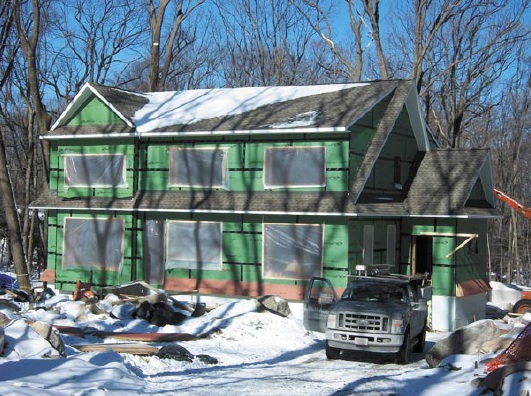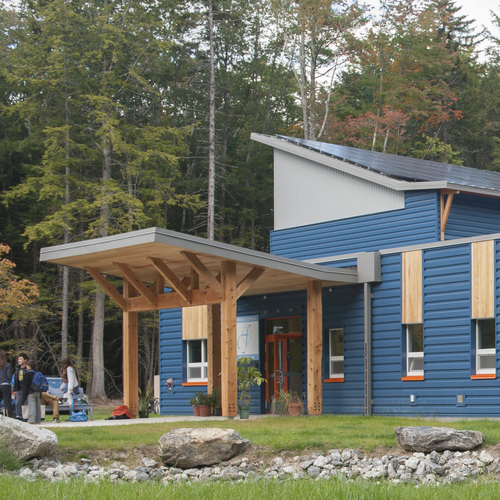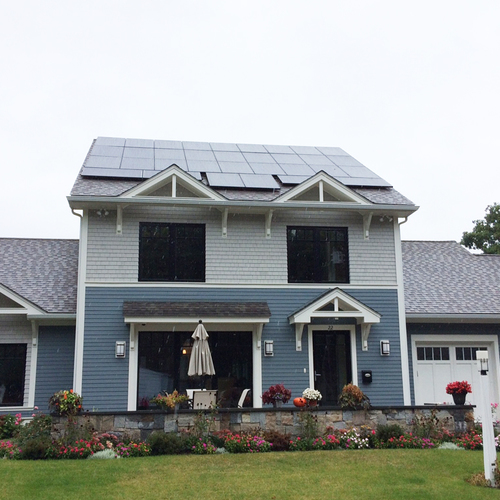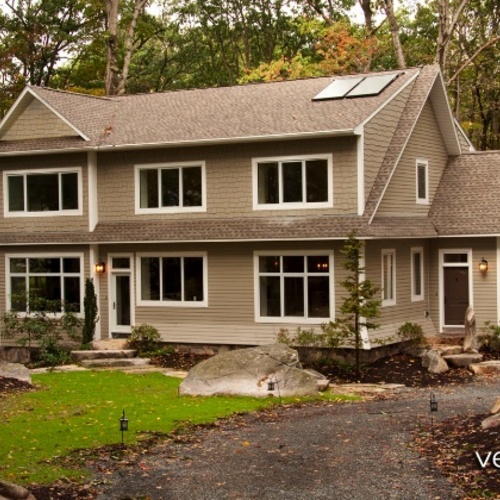Image Credit: DEAP Energy Group
Image Credit: DEAP Energy Group The Beaton house includes 3,000 sq. ft. of interior space. Recently elected to the Massachusetts state legislature, builder Matthew Beaton worked with DEAP Energy Group to bring the house to the Passivhaus standard.
UPDATE: We’ve replaced the images of the house in East Falmouth with a construction photo of the Beaton house and two layout drawings of the project.
Matthew Beaton, a builder who last fall was elected to serve as state representative for the 11th Worcester district in Massachusetts, doesn’t seem to have trouble reckoning his Republican Party affiliation with his preference for building green. Evidence of that is his nearly completed home, in Shrewsbury, which has been built to meet the Passivhaus standard.
With its traditional styling, the two-story, 3,000-sq.-ft. structure blends in well among the older homes that populate the neighborhood. And as Beaton noted in a story recently published by the Worcester Telegram, care was taken to disturb as few natural features of the construction site as was practical. Granite slabs became front steps and the red oak trees felled to make room for the house were milled for its hardwood floors.
“It’s the idea, ‘If you have it here, let’s use it here,’ ” Beaton told the Telegram. He added that, while he is now in listen-and-learn mode in the state legislature, he believes there are ways to use state law to promote energy efficiency and environmental stewardship in residential construction. He just needs to forge the right political path to make that happen.
Working toward certification, and building public awareness
His Republican colleagues, for example, tend not to be fans of the stretch-code provision of Massachusetts’ building energy code, which allows municipalities to impose stricter energy efficiency requirements on residential and commercial projects. But Beaton points out that legislative remedies, such as a requirement for energy efficiency ratings on homes offered for sale, don’t necessarily have to be expensive or complicated for builders to follow.
Paul Panish, a principal at Newton-based DEAP Energy Group, whose specialties include Passivhaus consulting and deep energy retrofits, has been advising Beaton in his quest to bring the house to the Passivhaus performance standard. While awareness of the Passivhaus concept does seem to be growing in the U.S., along with the number of certified Passivhaus consultants, Panish notes that builders like Beaton, regardless of their politics, are still a relatively rare breed.
“To get our builders to that level is a major challenge,” he told the Telegram. “It’s difficult to convince someone to do this. It’s a hard sell when energy costs are so low.”
Triple-glazed Canadian windows and an R-126 ceiling
Panish told GBA that the project features fiberglass-casement Accurate Dorwin triple-pane windows, with glazing optimized for solar gain on southern exposures and for insulation value on the remaining exposures.
The slab floor is insulated with recovered expanded polystyrene. The foundation walls are constructed of insulated concrete forms (with EPS) and an interior seal coat of polyurethane spray foam. Foundation-wall interiors feature 6-in. framed stud bays filled with dense-pack cellulose. Above-ground framed walls are insulated with dense-pack cellulose, and also include a rain screen to further protect sheathing, Panish says. Ceilings are insulated with loose blown cellulose throughout.
The thermal resistance of the basement slab floor is R-41.3, the basement walls are R-51.8, the first-floor exterior walls are R-65.7, the second-floor exterior walls are R-58.2, and the ceiling is R-126.2.
Weekly Newsletter
Get building science and energy efficiency advice, plus special offers, in your inbox.
















10 Comments
R-126.2!?1
with the volume that compact better Windows would have saved some serious coin in the roof. The plan leaves a lot to be desired
Response to Mike
Mike,
1. Triple-glazed Accurate Dorwin windows are good windows -- so I don't understand your criticism.
2. Be more specific: What's wrong with the plan?
windows
martin,
you are right, the windows aren't bad. i meant glazing. based on the amount of insulation, i would believe the SHGC on those things must be horrendous. however, according to this poster from the nov. PH conference, the southern glazing has an impressive SHGC of 0.64: http://www.deapgroup.com/Beaton_poster-s.pdf
so in the projects we've modeled in MA, with slightly better u-value and lower SHGC glazing, our insulation hasn't needed to be that high. so i feel there's a bit of a disconnect.
with regards to the plan... i could go on for a while. i'll start with the porch that's not a porch, the entry that's not an entry and opens up into the dining room, the 10' wide master BR and 2 awkwardly cramped and tiny bathrooms as opposed to one nice one. for a 3400 sf house (TFA is 3399 per the poster) - it's horribly cramped.
the poster does say that their projected heat demand is 3.10kBTU/ft2a - which means they could (and i'll say should) have dialed back elsewhere and been more effective with their 'design'.
however, the plans and images on the board don't match the plans and image on this post.
Response to Mike
Mike,
One person's "cramped" is another person's "appropriately sized." The American desire for bigger rooms needs to be dialed back.
Personally, I have no need for a big bedroom, as long as there is room for a bed. Nor do I need a big bathroom -- I don't spend much time in there. Who wants to hang out in a bathroom anyway?
But I know there are plenty of Americans who want a bathroom the size of a European living room. Not me.
european living rooms
ours were all pretty small growing up. i don't need a huge bathroom, but the ones on this plan are insanely tight.
i'll agree that the desire for bigger rooms (and houses) should be dialed back (and luckily seems to be going in this direction, albeit slowly).
a 3,400 sf house, even if it's a passivhaus, borders on greenwashed lipstick on a pig. or in this case, an elephant.
Clarification
I wanted to chime in here just to clarify a few things here.....not to get into a back and forth on opinions of appropriate house size or layout, but rather to clear up some facts. Everybody has their own opinions on what is right and what is wrong...that is what makes this world interesting, if nothing else.
The plans attached to this article are not the plans to our house. They are for the Cape Cod House referenced under the picture. This is another house worked on by DEAP Energy Group - who I might ad are a great group of guys to work with. We have a completely different layout that took many months to get "just right" in our opinion. The flow and openness is great and the house could not be more comfortable to live in. The best part is that there is virtually no heating bill after this crazy winter over here in the east. Must have been the extra insulation in the attic..
Cellulose was used in the walls and ceilings and is manufactured locally using local daily papers.....the product we used probably traveled less than 100 miles once it was printed. that is why we went with it. The extra insulation in the ceiling is likely due to our company working with this product on a daily basis and our attitude was "while we are up here, we might as well add a little extra insulation to be safe". The coin in that roof was some of the best spent coin in the project. Alittle more here a little exra effort there was our mindset throughout the project.....that is what got us to 240 [email protected] below what the model required. A little extra time and energy let me sleep at night while we were building. Looking back, it was the right move.
Overall, my wife and I could not be more happy with the final product. The size, the layout, the comfort, and the heating bills! We had a great time building our home and are having an even better time living there. It might not be the right fit for everyone, but for us it is just right.
Thank you for the response, Matthew
And, as noted in the update at the top of the post, we've replaced the images of the three-bedroom Cape Cod in East Falmouth with a construction photo of your project and two layout drawings.
Thanks Richard
That is great. Thanks for making the changes Richard and great article.
Additional clarification and thoughts on the design process
I’d like to clarify a few points that have been raised in regards to this project. This should act as an aid to understanding the as-built characteristics of this home, and as a precaution on how the Passive House design process should be approached overall.
Mike Eliason is correct when he sees “a bit of a disconnect” with regard to insulation levels, and states that the design “could have been dialed back” in regards to the value for normalized heating energy. I agree with his thoughts in many respects. The Passive House design process is intended to be front loaded, with the design and all major building components being carefully analyzed in advance of beginning construction.
The Beaton Residence, in an earlier incarnation, had been conceived some time before Matt was aware of the Passive House movement. When an analysis of the planned design was conducted it was found to be infeasible to adapt to meet the PH standard and a redesign was begun. Due to time constraints at this point it was not possible to do more than verify architectural concepts before construction had started.
As a result of these constraints, decisions on major components (such as window sizing, location, glazing characteristics, basement thermal boundary, among others) were being made after sections had been designed, as other building components were under construction, and the project was in a general state of flux. Due to the uncertainty this process introduced, each time a decision point was reached a conservative approach was decided on in the absence of finalized modeling information. The accumulation of a number of such decision points, along with Matt’s decision to go with higher quality materials in general, added up to a final product which significantly exceeded planned targets. The incredibly high insulation level in the ceilings was never a design specification, but was more a result of Matt’s being the contractor as well as the homeowner, having the materials on hand, and deciding he’d rather use them than keep them in storage for a future project.
I find this experience to be a valuable lesson in the justification for carrying out the analysis and pre-certification components of the PH design process. That being said, since the bulk of the insulation that went into exceeding the desired target values was cellulose, there was relatively little cost, embodied energy, or GWP concerns in the approach taken. You could consider the home to be a small scale carbon sequestration project.
Matt’s overall dedication to seeing the project through was quite admirable. His ability to deal with the diverse problems that inevitably arise when you take on a new and unfamiliar technology were impressive to say the least.
The PHPP model for Matt’s home is in the process of being finalized at this time. It appears the final value for specific heat energy will come in at 3.7 kBtu/sq.ft.- yr, not quite as far overboard as earlier estimated, but still in excess of the target.
My thanks to everyone who has been involved in this project and who have contributed to and commented on this article.
Passive House and conservatism...
Go Matthew! Thanks for sharing this story.
When it comes down to it, shouldn't political conservatives be all over deep energy efficiency, Passive House etc.? This is the foundation of a conservative mindset: do everything possible to minimize the "need" for gov't subsidies of energy, hedge against future environmental & political unknowns, essentially prepare for the worst-possible scenarios (ie be conservative)...
And long-term it would even be conservative to copy conservative-liberal Austria and give huge subsidies to deep energy retrofits. As they found by crunching the numbers, it's win-win: cheaper than nuclear, few "NIMBY" or environmental roadblocks as with nuclear or other power plants, savings are greater and locked in for the life of the building. Plus people's quality of life can be greatly improved, so you get community buy-in too.
And in case of earthquakes, tsunamis, avalanches, landslides, floods, meteors, bombs, fires--wouldn't everyone rather have a super-insulated home or office building with amazing windows than a nuclear plant?
Log in or create an account to post a comment.
Sign up Log in